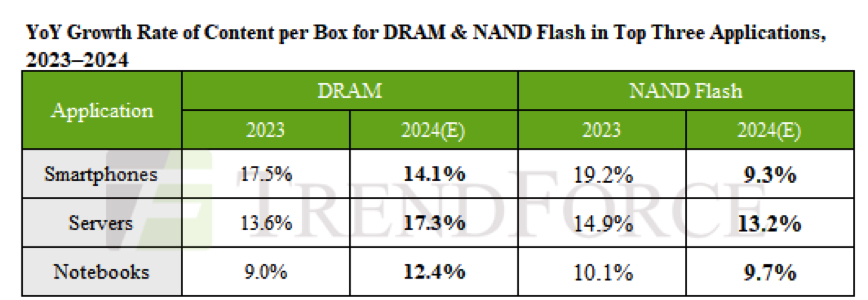Server DRAM 2024 Predictions
Yearly growth rate of 17.3%, and enterprise SSDs around 13.2%
This is a Press Release edited by StorageNewsletter.com on February 8, 2024 at 2:02 pm![]() Published on February 4, 2024, this market report was written by Avril Wu, senior manager, TrendForce Corp.
Published on February 4, 2024, this market report was written by Avril Wu, senior manager, TrendForce Corp.
AI’s Rocketing Demand to Drive Server DRAM
2024 Predictions Show a 17.3% Annual Increase in Content per Box, Outpacing Other Applications
In 2024, the tech industry remains steadfastly focused on AI, with the continued rollout of advanced AI chips leading to significant enhancements in processing speeds. Analyst posits that this advancement is set to drive growth in both DRAM and NAND flash across various AI applications, including smartphones, servers, and notebooks. The server sector is expected to see the most significant growth, with content per box for server DRAM projected to rise by 17.3% annually, while enterprise SSDs are forecast to increase by 13.2%. The market penetration rate for AI smartphones and AI PCs is expected to experience noticeable growth in 2025 and is anticipated to further drive the average content per box upward.

Looking first at smartphones, despite chipmakers focusing on improving processing performance, the absence of new AI functionalities has somewhat constrained the impact of AI. Memory prices plummeted in 2023 due to oversupply, making lower-priced options attractive and leading to a 17.5% increase in average DRAM capacity and a 19.2% increase in NAND flash capacity per smartphone. However, with no new applications expected in 2024, the growth rate in content per box for both DRAM and NAND flash in smartphones is set to slow down, estimated at 14.1% and 9.3%, respectively.
The server industry, benefiting from rising demand for AI servers, has seen the introduction and mass production of advanced AI chips by key players such as Nvidia, AMD, and CSP ASICs. Since training AI servers, which predominantly use DRAM for high-speed computing, currently lead the market, DRAM is expected to show a higher growth in content per box than NAND flash with server DRAM anticipated to have a yearly growth rate of 17.3% and enterprise SSDs around 13.2%.
Lastly, in the notebook market, Microsoft’s AI PC specs require CPUs with a capability of over 40 TOPS, met by processors like Qualcomm’s Snapdragon X Elite, AMD’s Ryzen 8000 series (Strix Point), and Intel’s Lunar Lake. However, notebooks equipped with these CPUs are expected to become widely available only in the latter half of 2024, thus providing limited short-term impetus for increasing memory capacity.
The primary requirement for AI PC hardware is expanding DRAM capacity to 16GB, with no corresponding demand for a 1TB SSD. Therefore, the Y/Y growth rate for DRAM in laptops is projected to be around 12.4%. This growth is expected to be more pronounced in 2025 as AI PCs enter mass production. Meanwhile, client SSDs are also on an upward trend in terms of content per box, but due to a sharp rebound in NAND flash prices, their annual growth rate is estimated to be only 9.7%.













 Subscribe to our free daily newsletter
Subscribe to our free daily newsletter


